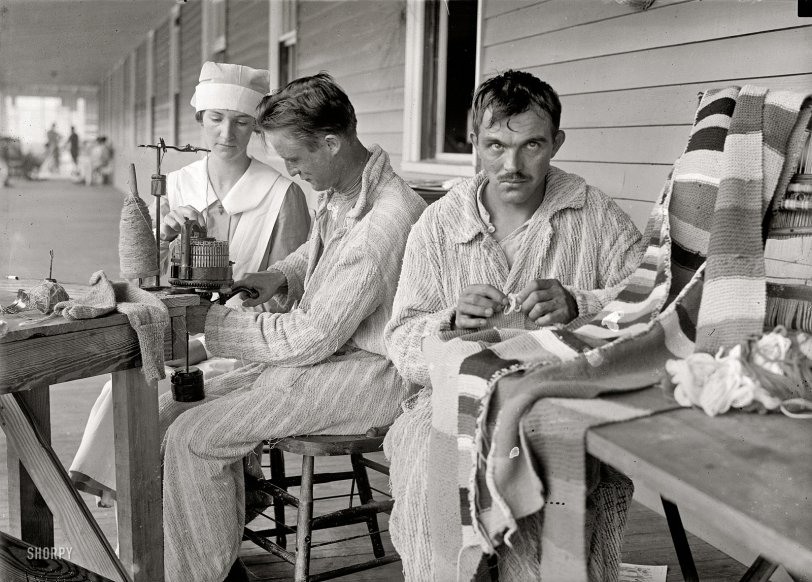


Framed or unframed, desk size to sofa size, printed by us in Arizona and Alabama since 2007. Explore now.
Shorpy is funded by you. Patreon contributors get an ad-free experience.
Learn more.

- Texas Flyer wanted
- Just a Year Too Soon
- WWII -- Replacing men with women at the railroad crossing.
- Yes, Icing
- You kids drive me nuts!
- NOT An Easy Job
- I wonder
- Just add window boxes
- Icing Platform?
- Indiana Harbor Belt abides
- Freezing haze
- Corrections (for those who care)
- C&NW at Nelson
- Fallen Flags
- A dangerous job made worse
- Water Stop
- Passenger trains have right of way over freights?
- Coal
- Never ceases to amaze me.
- Still chuggin' (in model form)
- Great shot
- Westerly Breeze
- For the men, a trapeze
- Tickled
- Sense of loneliness ...
- 2 cents
- Charm City
- What an Outrage
- Brighton Park
- Catenary Supports
Print Emporium
Home Again: 1918

"Army soldiers, Walter Reed Hospital." Back from the trenches in Washington, D.C., circa 1918. Harris & Ewing Collection glass negative. View full size.
Knitting as therapy
Knitting and other needle crafts were widely used as occupational therapy during both World Wars. It also was used in refugee camps in Asia Minor (according to one of my old needlework magazines) as a coping mechanism for children, to soothe them and get them to calm down. Speaking as a knitter/tatter/seamstress/etc, I find most forms of needle crafts very soothing.
And logistically it is a great choice as needles and yarn are portable and don't take up lots of storage space (unless you have a stash as large as mine).
Heavy Knitting
When you are using either a sock (shown) or flatbed knitting machine, you use weights to pull on, or tension, the already knit material. It keeps the knitted stitches out of the way of the ones currently on the needles. There are groups solely devoted to antique sock knitting machines and a company in New Zealand that produces new sock knitting machines based upon the antique machines.
Weighty
What were the hanging weights for? Maybe to keep tension on the yarn?
An old yarn
I would love to have that knitting machine!
On a side note, speaking of "women's work," my dear grandfather took up cross-stitching when recuperating after World War II. He enjoyed it immensely and found it to be very relaxing. He kept it up until his death in 2007. He would do a couple stitches on whatever he was working on each day after smoking his after lunch pipe. He made gorgeous tablecloths and other items as gifts for everyone in the family.
Women's Work?
Tell that to Rosie Grier. And if you don't know who Rosie is, Google him.
[And if that doesn't work, try googling Rosey Grier. - Dave]
Women's work?
If you look at the history of knitting, it was solely men's work at one point, when it was mostly used to produce caps and stockings. Before the various knitting machines came along, there were entire villages in England devoted to knitting stockings, and then it was the work of the whole family. Only when knitting became less necessary and more of a recreational activity did it become solely women's work.
During the war, knitting was pushed on everyone, regardless of age or gender, as a way to help the war effort. It was considered therapeutic for patients, and probably wasn't humiliating at all.
Smoke Em if You Got Em
Check out the burning cigarette by the young lady.
From man's work to women's work
It seems odd that soldiers who had recently been engaged in that most masculine of work--war--should have been given women's work to do in their recuperation. It could have been either very soothing or very humiliating.
Got Yarn?
"Yeah I knit. You got a problem with that?"
Thousand-yard stare
Looks like the shell shock hasn't quite worn off yet.
999 scarves left to go
The guy on the right appears to need a bit more rehab.
Stick to your knitting
The man on the left is using a circular sock knitting machine, which is a pretty cool (and rather complicated) gadget.
























On Shorpy:
Today’s Top 5